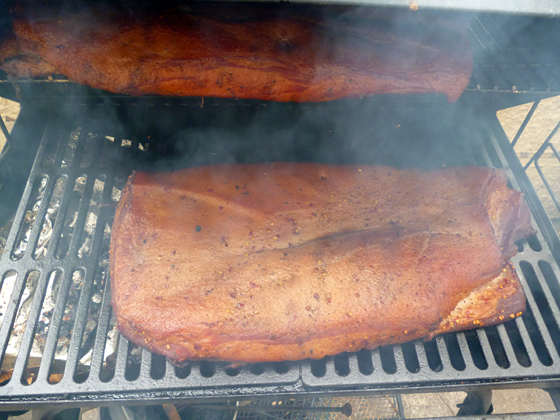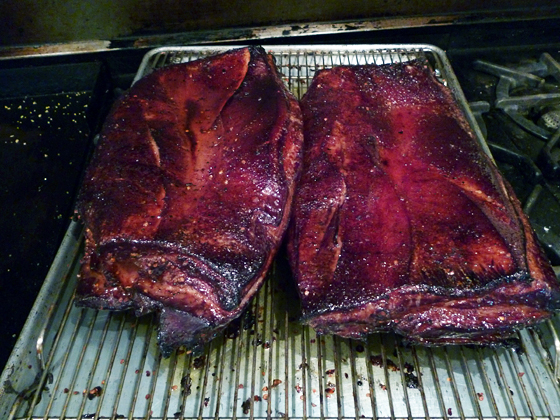
Bacon slabs, just out of the smoker, ready for the oven.
The result, eschewing all modesty, is fantastic. Right out of the oven, the slabs are deep red-brown, lacquered like a Peking duck, with an outrageously appetizing aroma. Because our bacon doesn’t have to last for weeks in a butcher’s case or grocer’s fridge (we freeze it immediately and defrost it chunk by chunk as needed), we can make our cure lighter on both the salt and “pink salt” than most commercial versions. Enough to cure it safely, of course, but light enough that you can taste the flavor of the pork and aromatics as well, without your tongue being clubbed by salt. (What is pink salt, you ask? Also known as curing salt, DC cure, or DQ cure, it is a mixture of 6.25% sodium nitrite and 93.75% sodium chloride, or table salt. The nitrites in the salt mixture help prevent bacterial contamination and also preserve the meat's color during the curing process. It is dyed pink to prevent it from being confused with regular salt.)
This last time we made bacon, we added maple syrup to a simple salt-and-pepper cure, to make something straightforward and breakfast-y out of half the meat. The other half became pancetta, cured without syrup but with more spices and aromatics, including plenty of rosemary. After curing, the meat was rolled and tied but not smoked, to make a savory bacon in the European style, useful as a base for sauces, stews, and ragus.
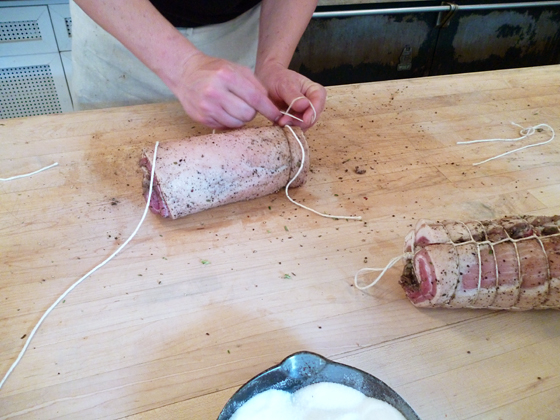
Damon LIttle tying pancetta.
Any pieces of the bacon or pancetta not immediately fried up for brunch quickly find a home: turned into lardons for salad, sautéed with onions, carrots, and celery to give a backbone to lentils or duck-and-bean soup, or simply cooked up for a kitchen-crew snack on yesterday’s sourdough bread, piled with sliced tomatoes and a smear of leftover garlic mayonnaise or Caesar dressing.
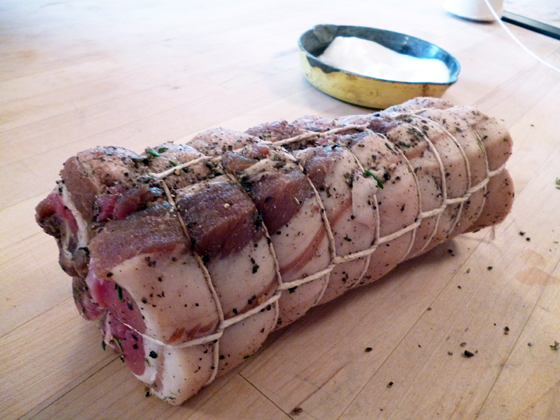
Pancetta
Given that we generally cure and smoke four big slabs of organic Berkshire pork from Idaho’s Snake River Farms at a time, the savings in the kitchen budget are significant. High-quality, organic bacon like this would probably cost us four times what the plain pork belly does. When you’re a non-profit cooking daily for 25 to 30 people, sometimes for twice that, making your own value-added products in house is just good sense.
Good organic jam, free of high-fructose corn syrup and made with more fruit than sugar? Expensive, especially when one brunch can empty 3 or 4 fancy jars. A flat of organic, locally grown plums, a pound or two of organic sugar, a handful of lemons and a couple hours of my time? A much cheaper, and much more delicious, way to fill a pantry shelf. The apples from a staff member’s backyard tree are tasty but misshapen and pocked with holes, useless for out-of-hand eating. But a little time with a paring knife, an afternoon’s slow baking in the oven, and we have three quarts of autumn apple butter ready to be slathered on this Sunday’s waffles.
Waffles served with bacon, naturally. Having come to bacon late in life (my parents’ one nod to traditional Jewish dietary laws was no pork in the house), I’ve never felt confident cooking it, especially since every bacon-lover seems to have a different bacon ideal—rigid or floppy, nearly burnt or just sizzled. Here, I’ve learned a good trick for when you’re making bacon for a crowd, when frying up a single panful just won’t do. We cut our bacon in fairly thick strips, laying them out side by side on parchment-lined sheet trays and popping them into the oven to cook until just crisp. Take the slices off the trays and lay them out on cooling racks to drain; this keeps them from getting soggy with grease and steam while you go about prepping the mimosas and flipping the frittatas. Pour the excess grease off the baking sheets (into an old jar or bowl, not down the sink, since it will thicken and harden into a drain-blocking sludge as it cools). To reheat, slide the bacon, still on its racks, back onto the baking sheets, and return to the oven until crisp and hot. Serve immediately, if you can bear to let any of it leave the kitchen.
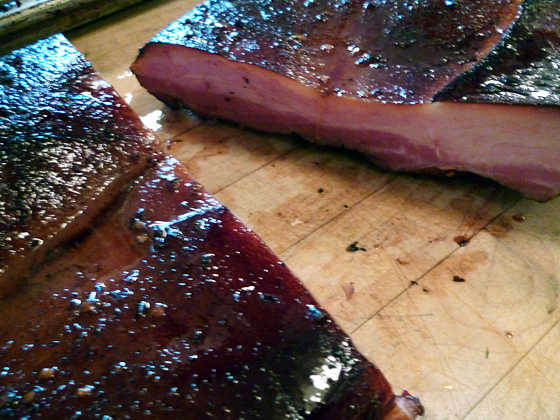
Final bacon
Recipe: Smoked Maple Bacon
Summary: The following recipe is adapted by Headlands kitchen intern Damon Little from Charcuterie: The Craft of Salting, Smoking, and Curing, by Michael Ruhlman and Brian Polcyn.
Prep Time: 60 minutes
Cook Time: 4 hours
Total Time: 5 hours, plus 8 days' curing time
Yield: About 4 lbs
Ingredients:
2 tbsp red pepper flakes, crushed in a mortar
1 tbsp freshly ground black pepper
1.75 oz kosher salt or sea salt (not iodized)
1/4 tsp pink salt (curing salt)
1/4 cup maple sugar or packed dark brown sugar
1/4 cup maple syrup (grade B has the most flavor)
One 5-lb slab pork belly, preferably from a pasture-raised animal
